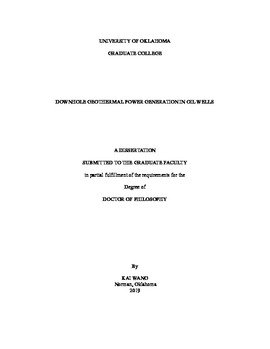| dc.contributor.advisor | Wu, Xingru | |
| dc.contributor.author | Wang, Kai | |
| dc.date.accessioned | 2019-11-26T18:58:07Z | |
| dc.date.available | 2019-11-26T18:58:07Z | |
| dc.date.issued | 2019-12-13 | |
| dc.identifier.uri | https://hdl.handle.net/11244/322822 | |
| dc.description.abstract | Sustainable production of sufficient energy to power the world’s economies with minimum environmental footprint have been one of the most significant challenges for decades. As an essential type of alternative energy, geothermal energy has been considered as one of the promising options to meet the world’s future energy demand with minimal visual and environmental impacts.
For decades, the utilization of geothermal energy mainly in regions with a high geothermal gradient with intense volcanic or hydrothermal activities. In addition to those areas, geothermal stored in hydrocarbon reservoirs also presents enormous potential, not only because massive geothermal energy is existing in oil and gas reservoirs, but also oilfields have enormous advantages to develop geothermal energy. Therefore, harnessing geothermal energy from oil wells features significant advantages over traditional geothermal wells, especially in reduced capital expenditure and operational risks. Some notable preliminary projects have been successfully conducted to recover geothermal energy from oil wells for power generation. However, there still exist challenges for the large-scale development of geothermal resources in oilfields under current technology.
This research is aiming to search for alternative geothermal power generation technology for enhanced geothermal production in mature oilfields. This work introduced thermoelectric technology and integrated it for downhole applications. Solid mathematical models are developed to simulate the temperature profile in the oil wells, and the models are used to determine the power generation performance to assess the technical and economic feasibility of downhole power generation designs in oil wells, and future application prospect is demonstrated as highly possible.
In practice, this work could act as a guide for oil and gas operators to evaluate their assets and identify the opportunity of oil-geothermal coproduction. This study also provided a refreshed mind of producing clean energy from fossil fuel assets. | en_US |
| dc.language | en_US | en_US |
| dc.rights | Attribution-NonCommercial-NoDerivatives 4.0 International | * |
| dc.rights.uri | https://creativecommons.org/licenses/by-nc-nd/4.0/ | * |
| dc.subject | Geothermal Energy | en_US |
| dc.subject | Heat Transfer | en_US |
| dc.subject | Oil wells | en_US |
| dc.subject | Thermoelectric technology | en_US |
| dc.title | Downhole Geothermal Power Generation in Oil Wells | en_US |
| dc.contributor.committeeMember | Lai, Feng | |
| dc.contributor.committeeMember | Ghassemi, Ahmad | |
| dc.contributor.committeeMember | Shiau, Benjamin | |
| dc.contributor.committeeMember | Fahes, Mashhad | |
| dc.date.manuscript | 2019-11-26 | |
| dc.thesis.degree | Ph.D. | en_US |
| ou.group | Mewbourne College of Earth and Energy::Mewbourne School of Petroleum and Geological Engineering | en_US |
| shareok.orcid | 0000-0003-2957-1969 | en_US |
| shareok.nativefileaccess | restricted | en_US |

